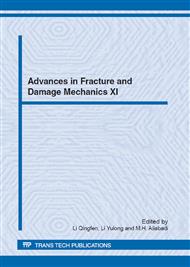p.49
p.53
p.57
p.61
p.65
p.69
p.73
p.77
p.81
Fracture and Damage Characterization of Natural Fiber Composites
Abstract:
This paper reports the microscopic fracture behavior of natural fiber-reinforced green composites. The acoustic emission (AE) method of nondestructive and real-time testing was applied to detect small-scale energy release phenomena during tensile deformation of the green composites. The unidirectional abaca fiber was embedded in a starch-based biodegradable resin matrix. Two kinds of pre-damaged abaca fibers as well as as-received (i.e. undamaged) fiber were used to examine the effect of the pre-damaged abaca fiber on the overall fracture behavior of the unidirectional green composites. In the case of the green composites reinforced with as-received abaca fiber, both of the tensile strength and fracture strain were relatively high. In the case of the green composites reinforced with pre-damaged abaca fiber, however, showed relatively smaller tensile strength and fracture strain. In addition, a wide range of amplitude AE events were measured during the tensile deformation. This tendency was enhanced in the composites reinforced with heavily damaged abaca fiber. The experimental results showed that the AE activity in the early deformation stage was associated with such the microscopic fracture of pre-damaged abaca fibers.
Info:
Periodical:
Pages:
65-68
Citation:
Online since:
November 2012
Authors:
Price:
Сopyright:
© 2013 Trans Tech Publications Ltd. All Rights Reserved
Share:
Citation:


